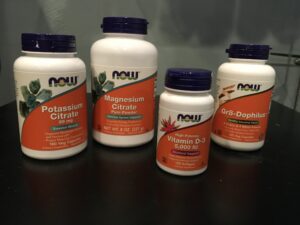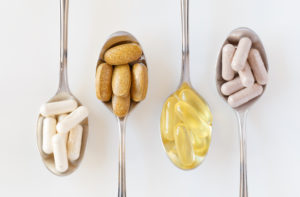Vitamin D has been in the news frequently lately. Research studies are pointing to it as an immune booster, COVID fighter, and diabetes preventer. This one very important vitamin may be a key link to the health of the American population and yet we consistently see deficiencies in many people. In this article we hope to highlight how Vitamin D deficiencies occur and how you can keep your levels at an optimal range.
1. Sun exposure
In a previous article we touched on how if you’re relying on sun exposure for more vitamin D, that not exposing enough skin, high sunscreen use, or lack of mid-day (10 am – 2 pm) exposure will limit vitamin D production. Environmental factors such as smog and cloud cover or residing in a higher latitude will also reduce exposure to UVB radiation. Additionally, the amount of melanin in the skin influences vitamin D production. Someone with more melanin (darker skin) might need 30 minutes in the sun to achieve the same production of vitamin D that someone with less melanin (lighter skin) will achieve in 10 minutes. While some people can achieve very high levels (~70 ng/ml) of vitamin D through sun exposure alone, others cannot achieve these levels without supplemental vitamin D.
2. Dietary intake of vitamin D
Certain foods that have naturally occurring vitamin D (e.g. fish, meat, and eggs) can impact vitamin D levels. Consistent intake of these foods is an important first line of defense against vitamin D deficiencies. Be cautious to not source your Vitamin D from foods that contain mostly vitamin D2 (not D3). This is true in foods such as mushrooms and some fortified drinks (e.g. rice milk and soy milk). While our body can use this form, it isn’t as effective as vitamin D3.
3. Vitamin D co-factors and competitors
 The intake of co-nutrients have been shown to impact vitamin D levels. For example, a lack of key vitamin D co-factors such as magnesium, vitamin K, potassium, boron, and zinc can reduce vitamin D absorption and production. On the other hand, a high intake of certain vitamins that compete with vitamin D, such as Vitamin A in the form of retinol or retinyl palmitate (not beta-carotene), can cause a reduction in vitamin D levels. This form of vitamin A is found in food from animal sources (especially liver) and some supplements. Also, some drugs including statins, prednisone and weight-loss drugs can block vitamin D.
The intake of co-nutrients have been shown to impact vitamin D levels. For example, a lack of key vitamin D co-factors such as magnesium, vitamin K, potassium, boron, and zinc can reduce vitamin D absorption and production. On the other hand, a high intake of certain vitamins that compete with vitamin D, such as Vitamin A in the form of retinol or retinyl palmitate (not beta-carotene), can cause a reduction in vitamin D levels. This form of vitamin A is found in food from animal sources (especially liver) and some supplements. Also, some drugs including statins, prednisone and weight-loss drugs can block vitamin D.
4. Time of supplement intake
Since vitamin D is a fat-soluble vitamin, taking it with a meal that contains fat can increase absorption. Also, adding a probiotic supplement can help with digestion in general and improve absorption of vitamin D.
5. Demographic characteristics
With increased age comes a reduced ability to absorb vitamin D through the skin and a reduction in the kidney’s ability to convert vitamin D to its active form. Also, smokers and those with a high BMI tend to have lower levels.
6. Medical conditions
A recent illness or injury may result in a lower vitamin D level. Also, digestive conditions such as irritable bowel disease, Crohn’s disease, leaky gut, or celiac disease can limit the absorption of vitamin D in the gut. Those with diseases of the liver (e.g. fatty liver) or pancreas, who have had their gallbladder removed, or who have had bariatric surgery bypassing the small intestine are more likely to have trouble absorbing or metabolizing vitamin D. For these individuals, an increased dosage or other vitamin D metabolites may be needed (please consult with your physician if this is the case).
Boosting your vitamin D levels
 Co-nutrients are nutrients that work together to accomplish a bodily process. If one co-nutrient is limited, either missing or not plentiful enough, then the process might also be limited. For example, your body needs magnesium for vitamin D metabolism; without sufficient magnesium, the amount of vitamin D that can be metabolized and used by your body is limited. Most studies point to over 50% more Vitamin D is needed to supplement the body properly when it is not taken with magnesium. When compared with someone taking magnesium and potassium together, a person taking vitamin D alone needs 244% more.
Co-nutrients are nutrients that work together to accomplish a bodily process. If one co-nutrient is limited, either missing or not plentiful enough, then the process might also be limited. For example, your body needs magnesium for vitamin D metabolism; without sufficient magnesium, the amount of vitamin D that can be metabolized and used by your body is limited. Most studies point to over 50% more Vitamin D is needed to supplement the body properly when it is not taken with magnesium. When compared with someone taking magnesium and potassium together, a person taking vitamin D alone needs 244% more.
Bone health is another example of the importance of co-nutrients with vitamin D. It is dependent upon metabolism of calcium, vitamin D, protein, and magnesium working together to maintain strong and healthy bones. If you are worried about your bone health and have been recommended to take calcium to strengthen them, be sure to add vitamin D and magnesium to your supplemental regimen. Adding protein to your plan will help to increase your muscle mass, which has also been shown to be an effective tool in increasing bone mass.
Troubleshooting your low vitamin D levels
If you have been consistently taking the same supplemental dose of vitamin D and experience a lower than expected vitamin D level, it’s possible that a change in diet, behavior, health, or the environment over the prior few months could have reduced your levels. Likewise, a recent illness or even the time of the day the test was taken can negatively impact your vitamin D levels. Your vitamin D levels can read 20% lower when taken in the early morning or evening compared to samples taken during the midday. Before any major changes to your supplemental regimen, I would suggest that you retest at least once.
If you are having difficulty increasing your levels, try increasing your dose, taking it with your largest meal, and optimizing vitamin D co-factors to improve your levels. If your low levels persist consider speaking with us to further investigate the absorption health of your gut or medications that may be possibly blocking vitamin D absorption.
Remember, the purpose of [Core] Chiropractic and Wellness is to see you become healthier than you have ever been. We will do whatever we can to help you achieve this goal. Feel free to email or call us with any questions. Stay healthy!
Stay healthy with Vitamin D and other Co-nutrients! 10% off Vitamin D, Magnesium, Potassium, and Probiotics now through August 20.
Daryl C. Rich, D.C., C.S.C.S







